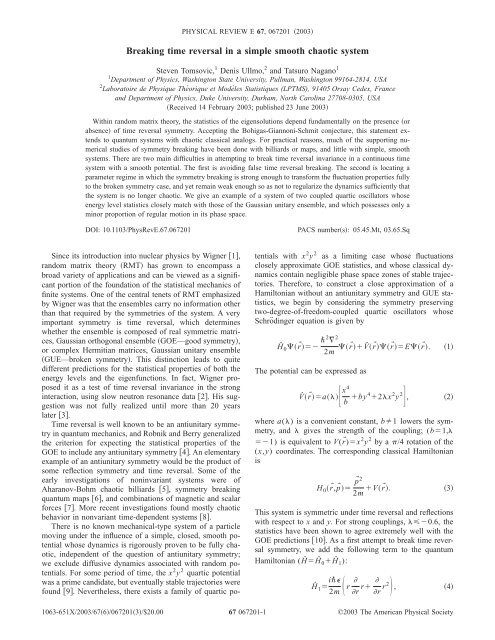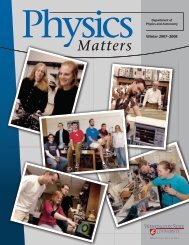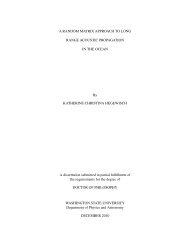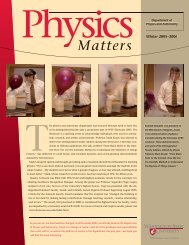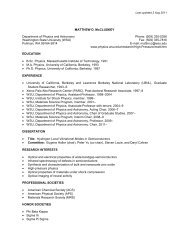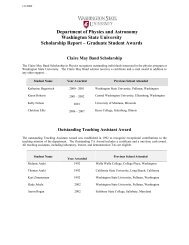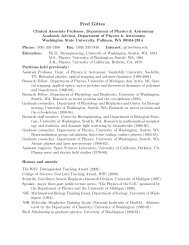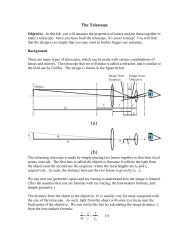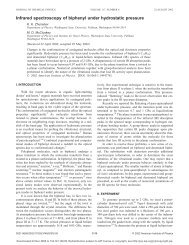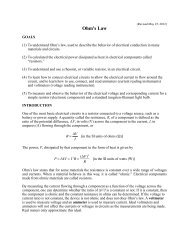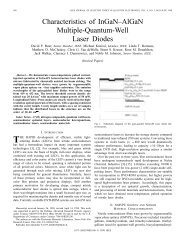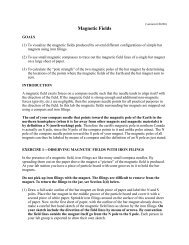Phys. Rev. E 67, 067201 (2003): Breaking time reversal in a simple ...
Phys. Rev. E 67, 067201 (2003): Breaking time reversal in a simple ...
Phys. Rev. E 67, 067201 (2003): Breaking time reversal in a simple ...
Create successful ePaper yourself
Turn your PDF publications into a flip-book with our unique Google optimized e-Paper software.
PHYSICAL REVIEW E <strong>67</strong>, 0<strong>67</strong>201 <strong>2003</strong><br />
<strong>Break<strong>in</strong>g</strong> <strong>time</strong> <strong>reversal</strong> <strong>in</strong> a <strong>simple</strong> smooth chaotic system<br />
Steven Tomsovic, 1 Denis Ullmo, 2 and Tatsuro Nagano 1<br />
1 Department of <strong>Phys</strong>ics, Wash<strong>in</strong>gton State University, Pullman, Wash<strong>in</strong>gton 99164-2814, USA<br />
2 Laboratoire de <strong>Phys</strong>ique Théorique et Modèles Statistiques (LPTMS), 91405 Orsay Cedex, France<br />
and Department of <strong>Phys</strong>ics, Duke University, Durham, North Carol<strong>in</strong>a 27708-0305, USA<br />
Received 14 February <strong>2003</strong>; published 23 June <strong>2003</strong><br />
With<strong>in</strong> random matrix theory, the statistics of the eigensolutions depend fundamentally on the presence or<br />
absence of <strong>time</strong> <strong>reversal</strong> symmetry. Accept<strong>in</strong>g the Bohigas-Giannoni-Schmit conjecture, this statement extends<br />
to quantum systems with chaotic classical analogs. For practical reasons, much of the support<strong>in</strong>g numerical<br />
studies of symmetry break<strong>in</strong>g have been done with billiards or maps, and little with <strong>simple</strong>, smooth<br />
systems. There are two ma<strong>in</strong> difficulties <strong>in</strong> attempt<strong>in</strong>g to break <strong>time</strong> <strong>reversal</strong> <strong>in</strong>variance <strong>in</strong> a cont<strong>in</strong>uous <strong>time</strong><br />
system with a smooth potential. The first is avoid<strong>in</strong>g false <strong>time</strong> <strong>reversal</strong> break<strong>in</strong>g. The second is locat<strong>in</strong>g a<br />
parameter regime <strong>in</strong> which the symmetry break<strong>in</strong>g is strong enough to transform the fluctuation properties fully<br />
to the broken symmetry case, and yet rema<strong>in</strong> weak enough so as not to regularize the dynamics sufficiently that<br />
the system is no longer chaotic. We give an example of a system of two coupled quartic oscillators whose<br />
energy level statistics closely match with those of the Gaussian unitary ensemble, and which possesses only a<br />
m<strong>in</strong>or proportion of regular motion <strong>in</strong> its phase space.<br />
DOI: 10.1103/<strong>Phys</strong><strong>Rev</strong>E.<strong>67</strong>.0<strong>67</strong>201<br />
PACS numbers: 05.45.Mt, 03.65.Sq<br />
S<strong>in</strong>ce its <strong>in</strong>troduction <strong>in</strong>to nuclear physics by Wigner 1,<br />
random matrix theory RMT has grown to encompass a<br />
broad variety of applications and can be viewed as a significant<br />
portion of the foundation of the statistical mechanics of<br />
f<strong>in</strong>ite systems. One of the central tenets of RMT emphasized<br />
by Wigner was that the ensembles carry no <strong>in</strong>formation other<br />
than that required by the symmetries of the system. A very<br />
important symmetry is <strong>time</strong> <strong>reversal</strong>, which determ<strong>in</strong>es<br />
whether the ensemble is composed of real symmetric matrices,<br />
Gaussian orthogonal ensemble GOE—good symmetry,<br />
or complex Hermitian matrices, Gaussian unitary ensemble<br />
GUE—broken symmetry. This dist<strong>in</strong>ction leads to quite<br />
different predictions for the statistical properties of both the<br />
energy levels and the eigenfunctions. In fact, Wigner proposed<br />
it as a test of <strong>time</strong> <strong>reversal</strong> <strong>in</strong>variance <strong>in</strong> the strong<br />
<strong>in</strong>teraction, us<strong>in</strong>g slow neutron resonance data 2. His suggestion<br />
was not fully realized until more than 20 years<br />
later 3.<br />
Time <strong>reversal</strong> is well known to be an antiunitary symmetry<br />
<strong>in</strong> quantum mechanics, and Robnik and Berry generalized<br />
the criterion for expect<strong>in</strong>g the statistical properties of the<br />
GOE to <strong>in</strong>clude any antiunitary symmetry 4. An elementary<br />
example of an antiunitary symmetry would be the product of<br />
some reflection symmetry and <strong>time</strong> <strong>reversal</strong>. Some of the<br />
early <strong>in</strong>vestigations of non<strong>in</strong>variant systems were of<br />
Aharanov-Bohm chaotic billiards 5, symmetry break<strong>in</strong>g<br />
quantum maps 6, and comb<strong>in</strong>ations of magnetic and scalar<br />
forces 7. More recent <strong>in</strong>vestigations found mostly chaotic<br />
behavior <strong>in</strong> nonvariant <strong>time</strong>-dependent systems 8.<br />
There is no known mechanical-type system of a particle<br />
mov<strong>in</strong>g under the <strong>in</strong>fluence of a <strong>simple</strong>, closed, smooth potential<br />
whose dynamics is rigorously proven to be fully chaotic,<br />
<strong>in</strong>dependent of the question of antiunitary symmetry;<br />
we exclude diffusive dynamics associated with random potentials.<br />
For some period of <strong>time</strong>, the x 2 y 2 quartic potential<br />
was a prime candidate, but eventually stable trajectories were<br />
found 9. Nevertheless, there exists a family of quartic potentials<br />
with x 2 y 2 as a limit<strong>in</strong>g case whose fluctuations<br />
closely approximate GOE statistics, and whose classical dynamics<br />
conta<strong>in</strong> negligible phase space zones of stable trajectories.<br />
Therefore, to construct a close approximation of a<br />
Hamiltonian without an antiunitary symmetry and GUE statistics,<br />
we beg<strong>in</strong> by consider<strong>in</strong>g the symmetry preserv<strong>in</strong>g<br />
two-degree-of-freedom-coupled quartic oscillators whose<br />
Schröd<strong>in</strong>ger equation is given by<br />
Ĥ 0 r <br />
2 2<br />
The potential can be expressed as<br />
2m r Vˆ r r Er .<br />
Vˆ r a x4<br />
b by4 2x 2 y 2,<br />
where a() is a convenient constant, b1 lowers the symmetry,<br />
and gives the strength of the coupl<strong>in</strong>g; (b1,<br />
1) is equivalent to V(r)x 2 y 2 by a /4 rotation of the<br />
(x,y) coord<strong>in</strong>ates. The correspond<strong>in</strong>g classical Hamiltonian<br />
is<br />
H 0 r,p <br />
p 2<br />
2m Vr .<br />
This system is symmetric under <strong>time</strong> <strong>reversal</strong> and reflections<br />
with respect to x and y. For strong coupl<strong>in</strong>gs, 0.6, the<br />
statistics have been shown to agree extremely well with the<br />
GOE predictions 10. As a first attempt to break <strong>time</strong> <strong>reversal</strong><br />
symmetry, we add the follow<strong>in</strong>g term to the quantum<br />
Hamiltonian (ĤĤ 0 Ĥ 1 ):<br />
Ĥ 1 i<br />
2m<br />
r <br />
r r <br />
r r2 ,<br />
1<br />
2<br />
3<br />
4<br />
1063-651X/<strong>2003</strong>/<strong>67</strong>6/0<strong>67</strong>2013/$20.00<br />
<strong>67</strong> 0<strong>67</strong>201-1<br />
©<strong>2003</strong> The American <strong>Phys</strong>ical Society
BRIEF REPORTS<br />
PHYSICAL REVIEW E <strong>67</strong>, 0<strong>67</strong>201 <strong>2003</strong><br />
FIG. 2. The x0 Po<strong>in</strong>caré surface of section for the Hamiltonian<br />
with the term from Eq. 11, and parameters (0.8,<br />
1) as <strong>in</strong> the bottom panel of Fig. 1. The coord<strong>in</strong>ates y and p y are<br />
<strong>in</strong> scaled units.<br />
FIG. 1. The number variance for the quartic oscillators solid<br />
l<strong>in</strong>es compared to the GOE and GUE dashed l<strong>in</strong>es. The upper<br />
panel shows the statistics for the hidden symmetry case, i.e., with<br />
the Hamiltonian term <strong>in</strong> Eq. 4 with (0.5, 0.65). The<br />
lower panel shows the results us<strong>in</strong>g the Hamiltonian term of Eq.<br />
11 and (1.0, 0.80). Spectra conta<strong>in</strong><strong>in</strong>g a total of 600<br />
levels were used to generate the statistics. The lowest 50 eigenvalues<br />
were dropped.<br />
where r is the radial polar variable. Ĥ 1 breaks <strong>time</strong> <strong>reversal</strong><br />
<strong>in</strong>variance <strong>in</strong> the Hamiltonian without alter<strong>in</strong>g the orig<strong>in</strong>al<br />
reflection symmetries, and thus does not admit an antiunitary<br />
symmetry from any comb<strong>in</strong>ation of reflection and <strong>time</strong> <strong>reversal</strong>.<br />
This term was chosen to ma<strong>in</strong>ta<strong>in</strong> a scal<strong>in</strong>g property<br />
of the eigensolutions of the quartic oscillators due to the<br />
homogeneity of the potential 10. However, Ĥ 1 gives us an<br />
excellent example of false symmetry break<strong>in</strong>g. In fact, it<br />
turns out that Ĥ 1 is given by the cross terms aris<strong>in</strong>g from a<br />
vector potential A(r)r 2 rˆ which can also be expressed as<br />
the gradient of a scalar function, i.e.,<br />
Ĥ 1 i<br />
2m “•Ar Ar •“.<br />
This means that, up to the addition to the potential of a term<br />
2 r 4 , H 1 can be understood as deriv<strong>in</strong>g from a magnetic<br />
field B“A0, which obviously will not change any<br />
physical quantity. And <strong>in</strong>deed, it is possible to make a gauge<br />
transformation and rewrite the wave function us<strong>in</strong>g the Dirac<br />
substitution<br />
5<br />
r exp i r Ar•dr r e<br />
ir 3 /3 r <br />
<strong>in</strong> order to cancel Ĥ 1 plus the afore-mentioned 2 r 4 term.<br />
Furthermore, the transformation is s<strong>in</strong>gle valued, s<strong>in</strong>ce B<br />
0 implies<br />
Ar•dr0.<br />
The expectation, follow<strong>in</strong>g the considerations of Ref. 4, is<br />
therefore to f<strong>in</strong>d the GOE statistics and not those of the<br />
GUE. See the upper panel of Fig. 1, which compares the<br />
number variance of the system i.e., the variance of the number<br />
of levels found <strong>in</strong> an energy <strong>in</strong>terval of width s scaled<br />
locally to mean unit level density with the predictions of the<br />
GOE and the GUE. The GOE statistics are closely matched<br />
to a mean level spac<strong>in</strong>g and a bit beyond. The parameter <br />
was chosen slightly greater than unity because this forced the<br />
eigenlevels through a couple of avoided cross<strong>in</strong>gs, which<br />
would have been sufficient to push the spectral fluctuations<br />
toward the GUE if the symmetry was not be<strong>in</strong>g falsely broken.<br />
From a classical perspective, the Hamiltonian, not <strong>in</strong>corporat<strong>in</strong>g<br />
the guage transformation, is<br />
p 2 r 2r 2 p r<br />
Hr,p p 2<br />
<br />
2m 2mr 2 Vr,,<br />
which itself appears to violate <strong>time</strong> <strong>reversal</strong> symmetry, as<br />
well as <strong>in</strong> Hamilton’s equations of motion:<br />
6<br />
7<br />
8<br />
0<strong>67</strong>201-2
BRIEF REPORTS<br />
PHYSICAL REVIEW E <strong>67</strong>, 0<strong>67</strong>201 <strong>2003</strong><br />
ṙ 1 m p rr 2 ,<br />
ṗ r Vr,<br />
2 r m rp r ,<br />
Ĥ 1 i<br />
2m cos2 r <br />
r r <br />
r r2 .<br />
11<br />
˙ p <br />
mr 2 ,<br />
ṗ Vr,<br />
. 9<br />
<br />
However, even without consider<strong>in</strong>g a canonical transformation,<br />
just by convert<strong>in</strong>g to the Lagrangian description of the<br />
dynamics us<strong>in</strong>g the left-hand side equations, it turns out that<br />
L 1 2 mṙ2 mr 2 2<br />
˙ 2Vr,<br />
2m r4 r 2 ṙ.<br />
10<br />
The f<strong>in</strong>al term, which appears to break the symmetry, cannot<br />
enter the equations of motion. They are <strong>in</strong>variant under addition<br />
of any total <strong>time</strong> derivative. It is not always obvious,<br />
a priori, whether a symmetry break<strong>in</strong>g term leads to false<br />
symmetry break<strong>in</strong>g or not.<br />
If we multiply the symmetry break<strong>in</strong>g term by any function<br />
of , it can no longer be a total <strong>time</strong> derivative, nor can<br />
the vector potential be expressed as the gradient of a scalar<br />
function. Consider<br />
The vector potential becomes A(r)r 2 cos 2 rˆ, and therefore<br />
B2xy/r0. The <strong>in</strong>tegrals A(r)•dr and<br />
A(r)•dr are path dependent. The Dirac substitution is<br />
not useful, and the false symmetry break<strong>in</strong>g is not an issue.<br />
Driv<strong>in</strong>g the eigenvalues at numerically atta<strong>in</strong>able energies<br />
through a couple of avoided cross<strong>in</strong>gs forces to be chosen<br />
<strong>in</strong> the neighborhood of unity. This has a strong regulariz<strong>in</strong>g<br />
effect on the nature of the dynamics. See the surface of section<br />
<strong>in</strong> Fig. 2 for the case 0.8,1. Only its spectrum<br />
gives number variance statistics close to the GUE results; see<br />
the lower panel of Fig. 1.<br />
To summarize, we have given an example of a <strong>simple</strong>,<br />
cont<strong>in</strong>uous, dynamical system that comes close to generat<strong>in</strong>g<br />
GUE statistics. It is surpris<strong>in</strong>gly difficult to f<strong>in</strong>d an essentially<br />
fully chaotic system that does so. The pitfall of false<br />
<strong>time</strong> <strong>reversal</strong> break<strong>in</strong>g can lead to symmetries that are quite<br />
well hidden, and the addition of a vector potential to a dynamical<br />
system has a strong tendency to move the system<br />
away from fully developed chaos.<br />
We gratefully acknowledge support from ONR Grant No.<br />
N00014-98-1-0079 and NSF Grant No. PHY-0098027.<br />
1 E.P. Wigner, Ann. <strong>Phys</strong>. N.Y. <strong>67</strong>, 325 1958; repr<strong>in</strong>ted <strong>in</strong><br />
Statistical Theories of Spectra: Fluctuations, edited by C.E.<br />
Porter Academic Press, New York, 1965; T.A. Brody, J.<br />
Flores, J.B. French, P.A. Mello, A. Pandey, and S.S.M. Wong,<br />
<strong>Rev</strong>. Mod. <strong>Phys</strong>. 53, 385 1981.<br />
2 E.P. Wigner, SIAM <strong>Rev</strong>. 9, 119<strong>67</strong>.<br />
3 J.B. French, V.K.B. Kota, A. Pandey, and S. Tomsovic, Ann.<br />
<strong>Phys</strong>. N.Y. 181, 198 1988; 181, 235 1988.<br />
4 M. Robnik and M.V. Berry, J. <strong>Phys</strong>. A: Math. Gen. 19, 669<br />
1986.<br />
5 M.V. Berry and M. Robnik, J. <strong>Phys</strong>. A: Math. Gen 19, 649<br />
1986.<br />
6 F.M. Izrailev, <strong>Phys</strong>. <strong>Rev</strong>. Lett. 56, 541 1986.<br />
7 T.H. Seligman and J.J.M. Verbaarschot, <strong>Phys</strong>. Lett. 108A, 183<br />
1985.<br />
8 K. Sacha, J. Zakrzewski, and D. Delande, <strong>Phys</strong>. <strong>Rev</strong>. Lett. 83,<br />
2922 1999; 84, 200E 2000; Ann. <strong>Phys</strong>. N.Y. 283, 141<br />
2000; K. Sacha and J. Zakrzewski, <strong>Phys</strong>. <strong>Rev</strong>. Lett. 86, 2269<br />
2001.<br />
9 P. Dahlqvist and G. Russberg, <strong>Phys</strong>. <strong>Rev</strong>. Lett. 65, 2837<br />
1990.<br />
10 O. Bohigas, S. Tomsovic, and D. Ullmo, <strong>Phys</strong>. Rep. 223, 43<br />
1993.<br />
0<strong>67</strong>201-3


